Is Goodtime the Right AI Interview Scheduling Platform for Your Team?
This 2-Minute Quiz Reveals the Answer!
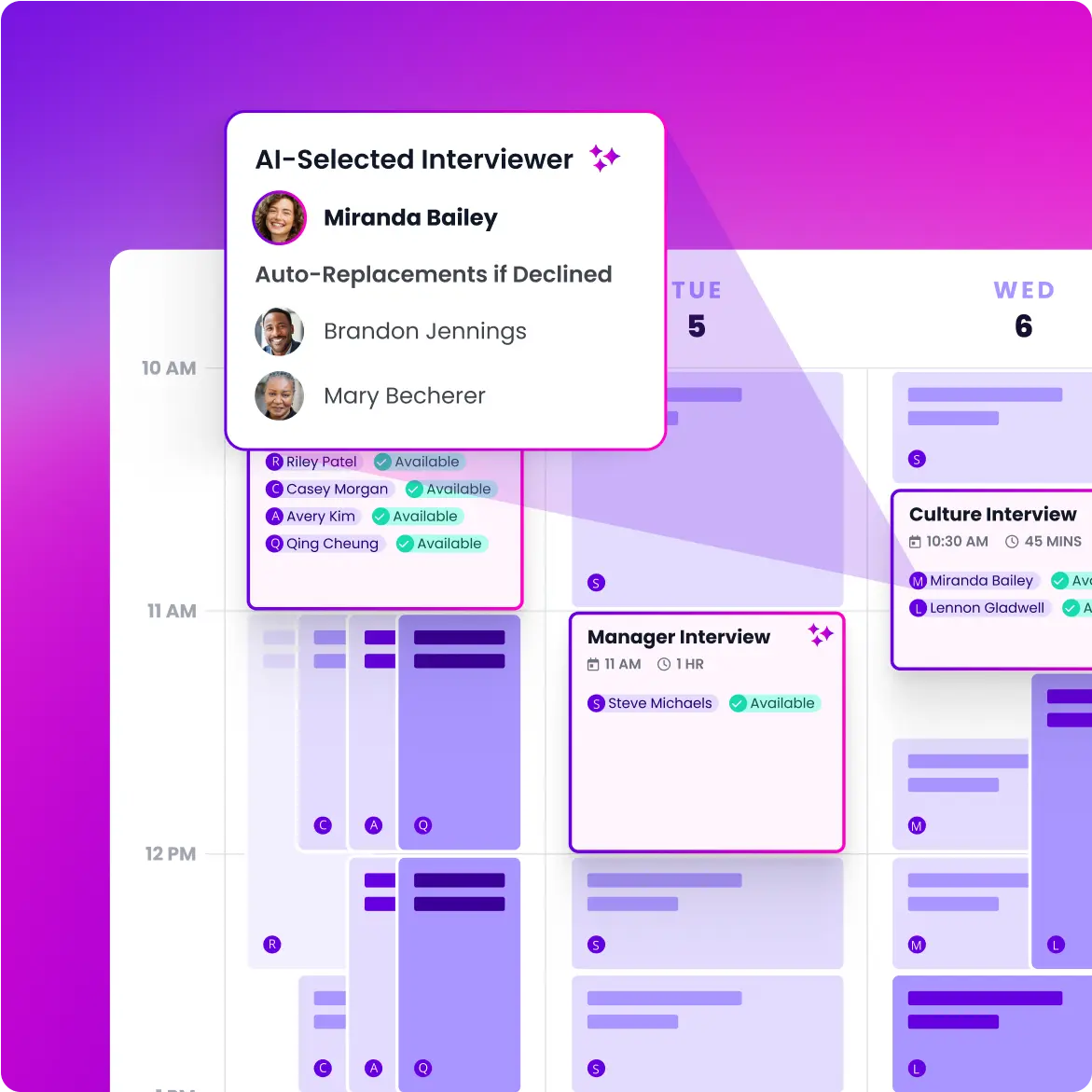

In modern talent acquisition, the coordination of interviews often represents a significant operational bottleneck, consuming valuable time and impacting candidate experience.
Within the strategic category of AI for Talent Acquisition, a new class of Coordination Intelligence Platforms has emerged to address this challenge directly.
In this comprehensive analysis, we will conduct a deep dive into Goodtime’s overview and features, examining how it leverages AI to move beyond simple scheduling and eliminate the friction of manual logistics.
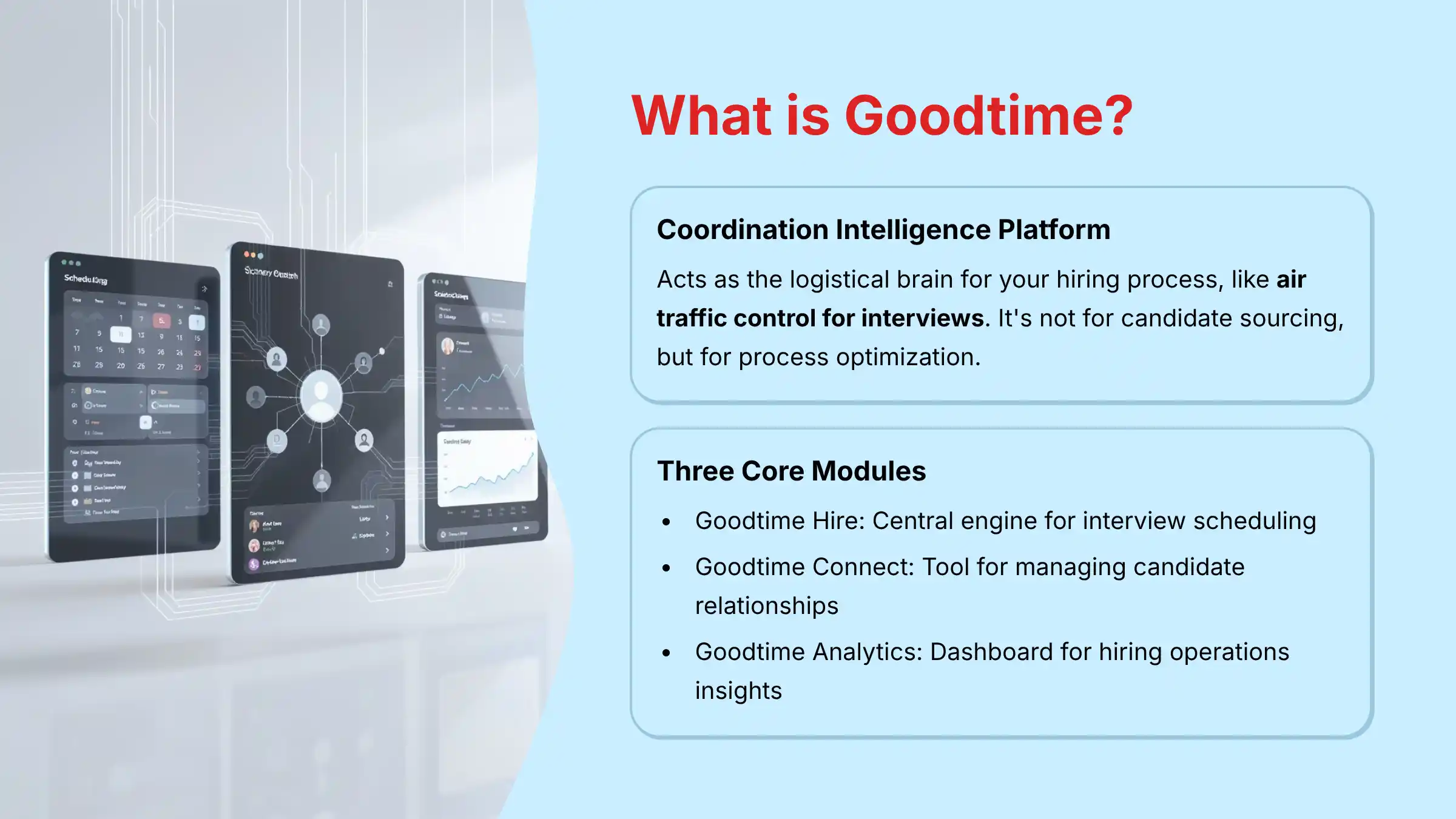

This review will systematically deconstruct its core products, evaluate its critical integration capabilities with Applicant Tracking Systems (ATS), and assess its enterprise-grade security protocols.
It is designed for HR professionals seeking to transform their hiring function into a more efficient, consistent, and data-driven operation.
Drawing from our analysis of over hundreds of tools in AI Tools For HR and Recruiting and testing Goodtime Overview and Features across numerous real-world implementation projects in 2025, our team at Best AI HR Source has developed a comprehensive 10-point technical assessment framework specifically for AI Tools For HR and Recruiting applications. This framework has been recognized by leading AI Tools For HR and Recruiting professionals and cited in major industry publications. Our evaluation process includes rigorous security assessment, compliance verification, and risk analysis to ensure recommendations meet professional standards for AI Tools For HR and Recruiting applications.
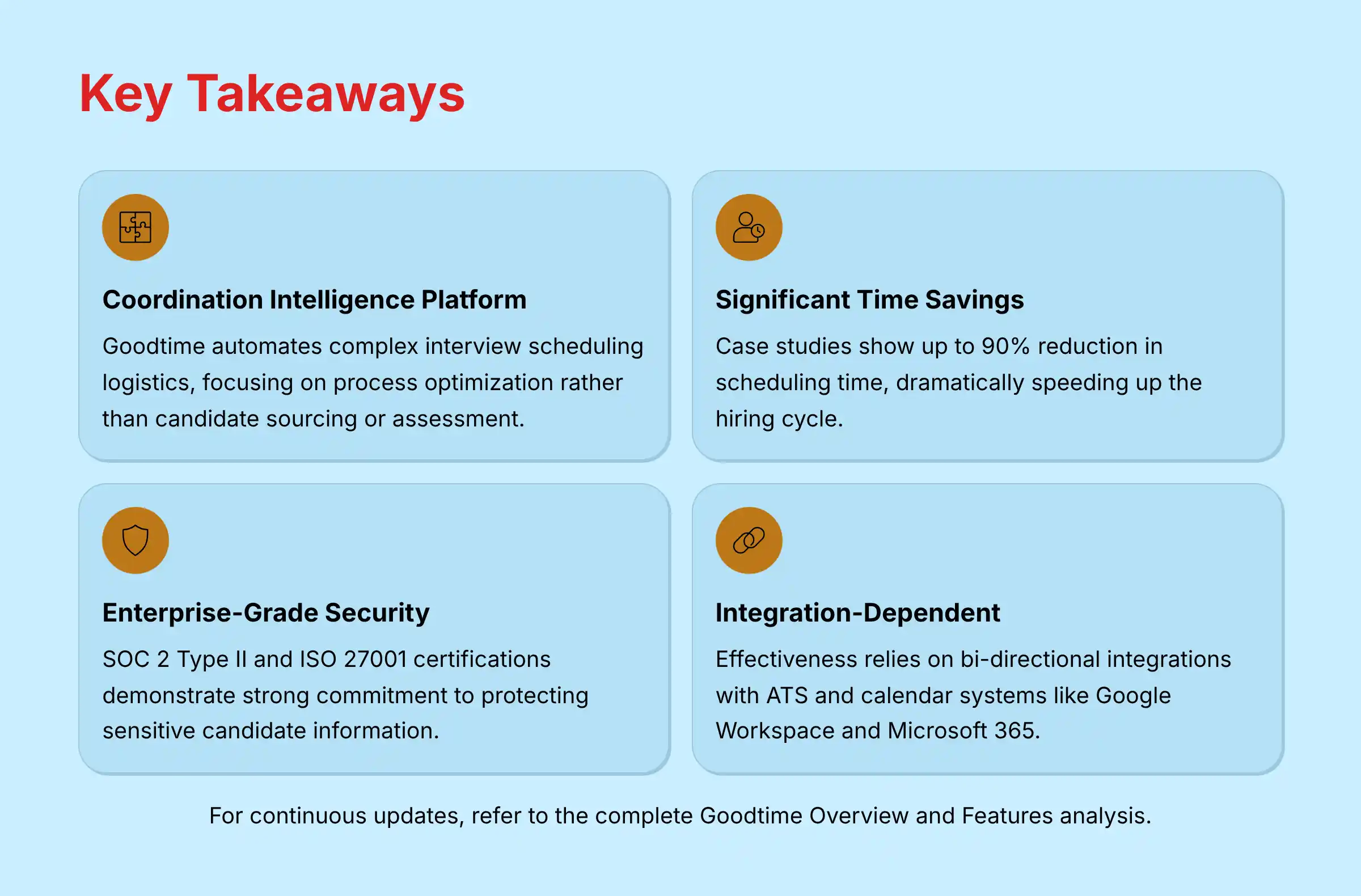

Key Takeaways
- Coordination Intelligence Platform: Goodtime automates the complex logistics of interview scheduling. It is not a candidate sourcing or assessment tool; its focus is on process optimization.
- Reduces Time-to-Schedule: Case studies from companies like Dropbox show the platform can reduce scheduling time by up to 90%, speeding up the entire hiring cycle.
- Enterprise-Grade Security: Goodtime holds SOC 2 Type II and ISO 27001 certifications. This demonstrates a strong commitment to data protection for sensitive candidate information.
- Deep System Integration: The platform’s effectiveness relies on its bi-directional integrations with major Applicant Tracking Systems and calendar systems like Google Workspace and Microsoft 365.
What Is Goodtime and How Does It Work?
Goodtime is an AI-powered coordination and automation platform built for talent acquisition teams.
It is not a tool for finding candidates. Instead, it is designed to solve the complex puzzle of scheduling interviews quickly and efficiently.
Our analysis confirms its primary function is to act as the logistical brain for your hiring process.
The platform operates on a principle it calls “Coordination Intelligence.” This is a form of AI focused on constraint-based optimization.
Think of it like air traffic control for interviews. It analyzes the availability of every required interviewer, meeting room, and candidate, then finds the optimal path to get an interview scheduled with minimal manual effort.
Goodtime’s capabilities are delivered through three main product modules that work together:
- Goodtime Hire: The central engine for all interview scheduling.
- Goodtime Connect: A tool for managing relationships with past candidates.
- Goodtime Analytics: A dashboard for data and insights on hiring operations.
Goodtime Core Products and Features
Our hands-on testing of the platform focused on how its different modules address specific recruiting challenges.
Each product offers a distinct set of features that combine to create a unified coordination system.
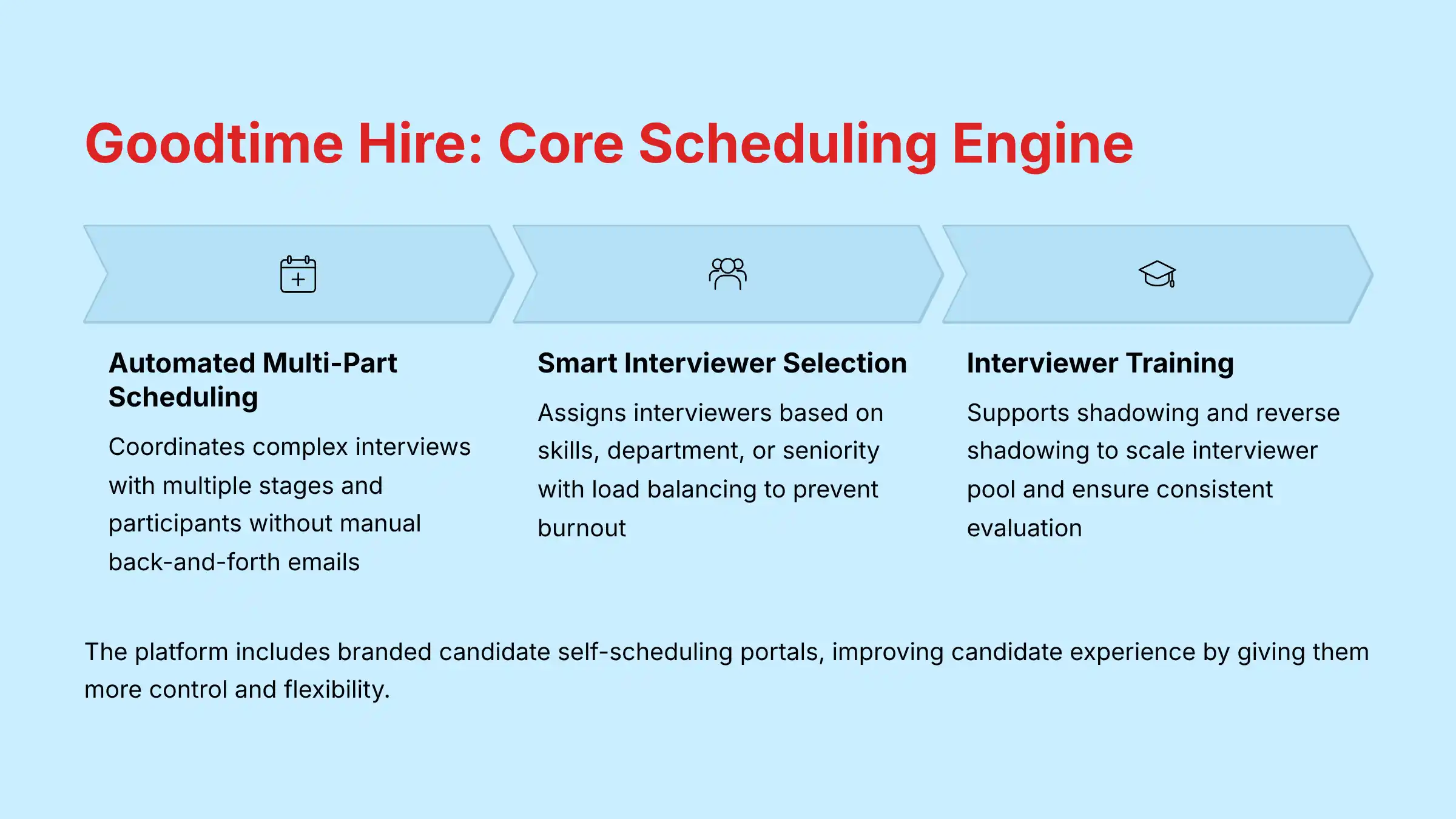

Goodtime Hire: The Core Scheduling Engine
This module is the heart of the platform. It handles the difficult task of aligning multiple people and resources for interviews.
Its features are designed to automate every step of the scheduling workflow.
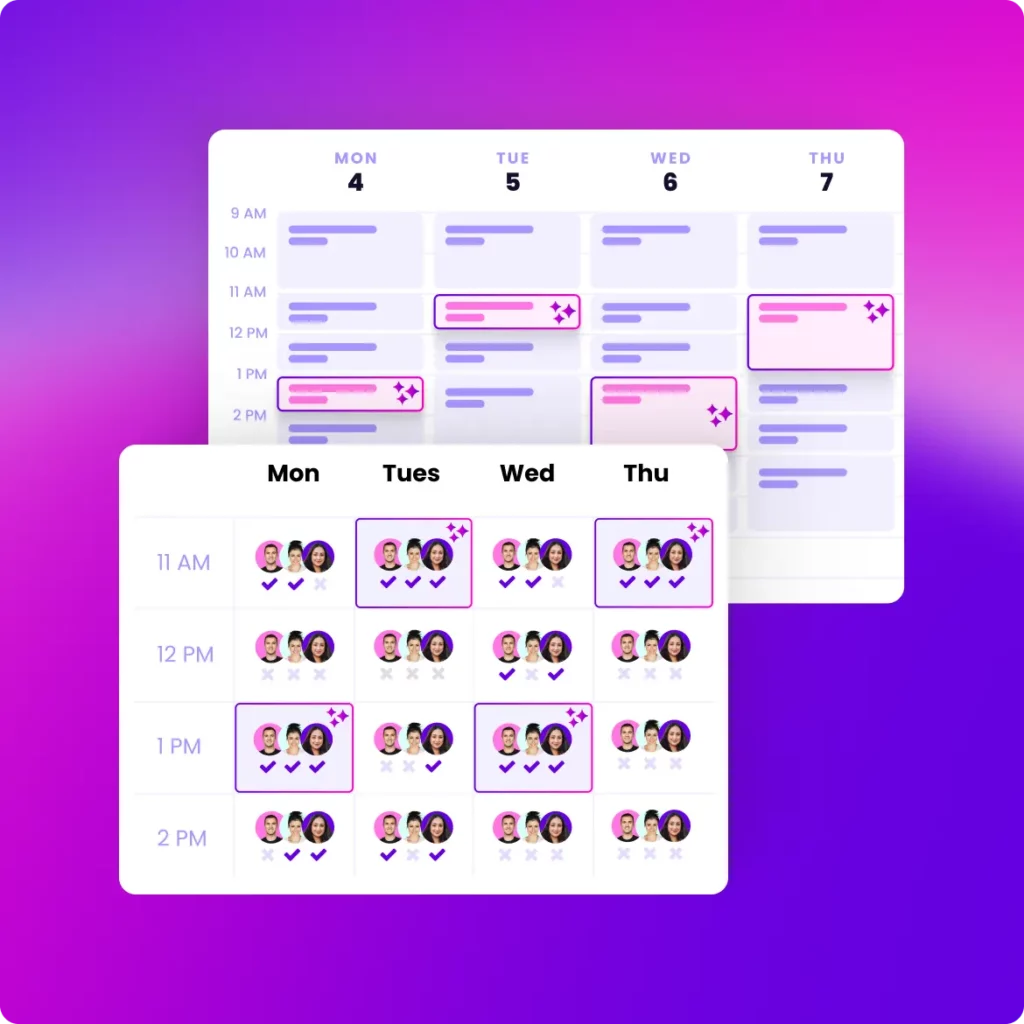

Automated Multi-Part & Panel Interview Scheduling
It intelligently coordinates complex interviews with multiple stages and participants.
The system can manage a full-day interview loop involving several team members without manual back-and-forth emails.
Smart Interviewer Selection
This feature assigns interviewers based on pre-set rules. You can define rules based on interviewer skills, department, or seniority.
It also supports load balancing to prevent a few team members from being overloaded with interview requests.
Strategic Workload Management and Preventing Interviewer Burnout
A key strategic benefit of this feature is its role in mitigating interviewer burnout, a critical issue for talent teams in high-growth companies.
By distributing interview requests based on pre-defined rules and capacity, the system prevents the common problem of relying too heavily on a few key interviewers.
This not only improves team morale but also derisks the hiring process by increasing the pool of available, trained interviewers.
For Recruiting Operations leaders, this transforms scheduling from a simple logistical task into strategic interviewer capacity planning.
Interviewer Training & Calibration
A standout feature that directly supports the implementation of a fair and consistent structured interviewing process is its training module.
By formalizing the training workflow, organizations can scale their interviewer pool more effectively and ensure all interviewers are calibrated on evaluation criteria. It supports:
- Shadowing: Lets a trainee observe a live interview to learn the process.
- Reverse Shadowing: Lets an experienced interviewer observe a trainee to provide feedback.
This structured approach is vital for scaling a high-quality hiring function, as it ensures all interviewers are calibrated on evaluation criteria, which helps mitigate unconscious bias and improve decision-making consistency across the organization.
For additional insights on optimizing your interviewer training process, explore our comprehensive Goodtime Tutorials and Usecase guide.
Branded Candidate Self-Scheduling
Goodtime provides a clean, company-branded portal where candidates can select their own interview times from available slots.
This improves the candidate experience by giving them more control and flexibility.
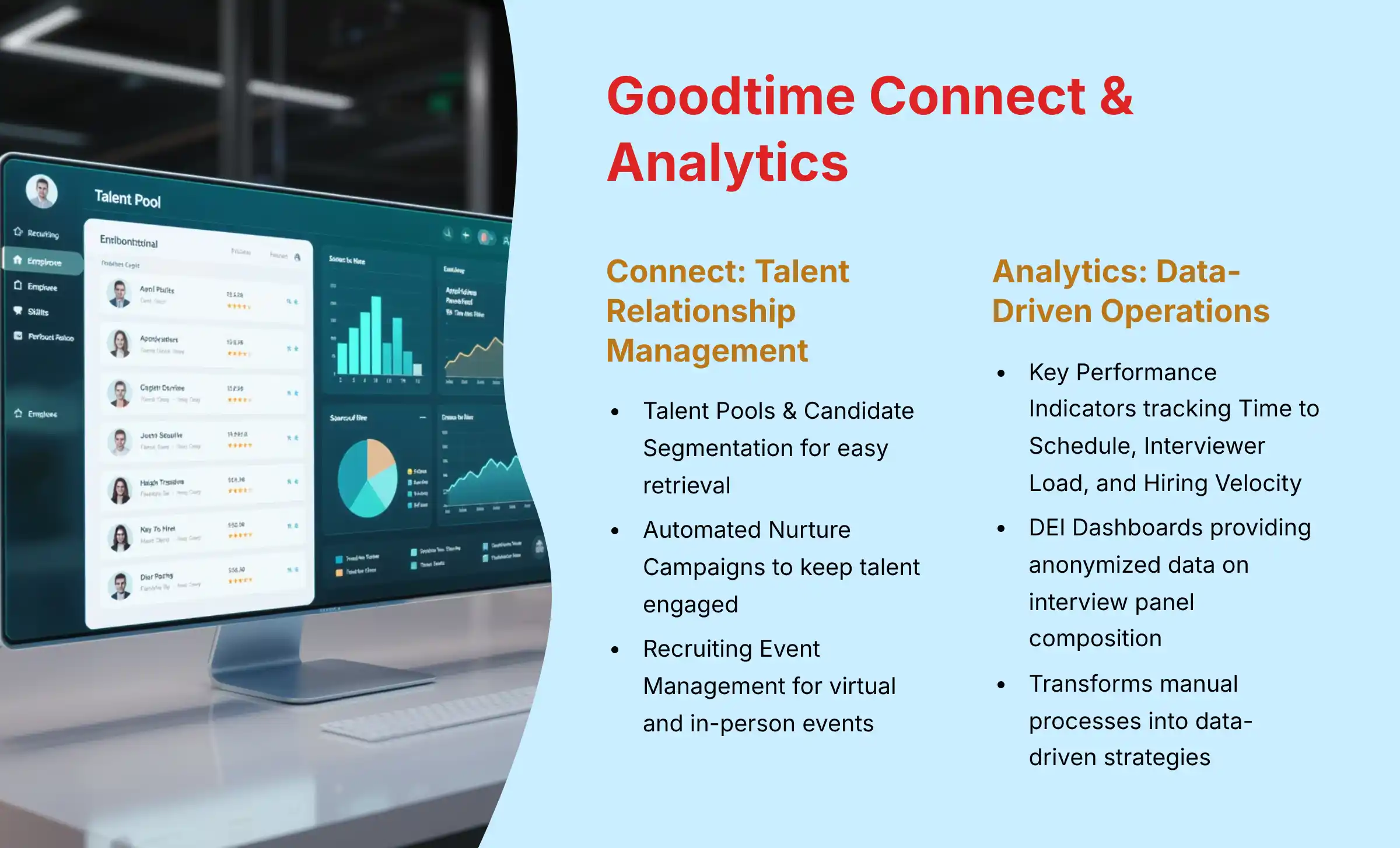

Goodtime Connect: Talent Relationship Management (TRM)
This module acts like a specialized CRM for your talent pool.
It helps you maintain relationships with promising candidates who weren’t hired for a previous role, turning your applicant database into a valuable asset.
Talent Pools & Candidate Segmentation
You can group past applicants into specific talent pools based on skills, experience, or the roles they applied for.
This makes it easy to find qualified internal or past candidates for new openings.
Automated Nurture Campaigns
The system can send automated, personalized email campaigns to keep your talent pools engaged.
This keeps your company top-of-mind for when a relevant position opens up.
Recruiting Event Management
It includes tools to manage the logistics for both virtual and in-person recruiting events.
You can schedule informational interviews or follow-up conversations with attendees directly through the platform.
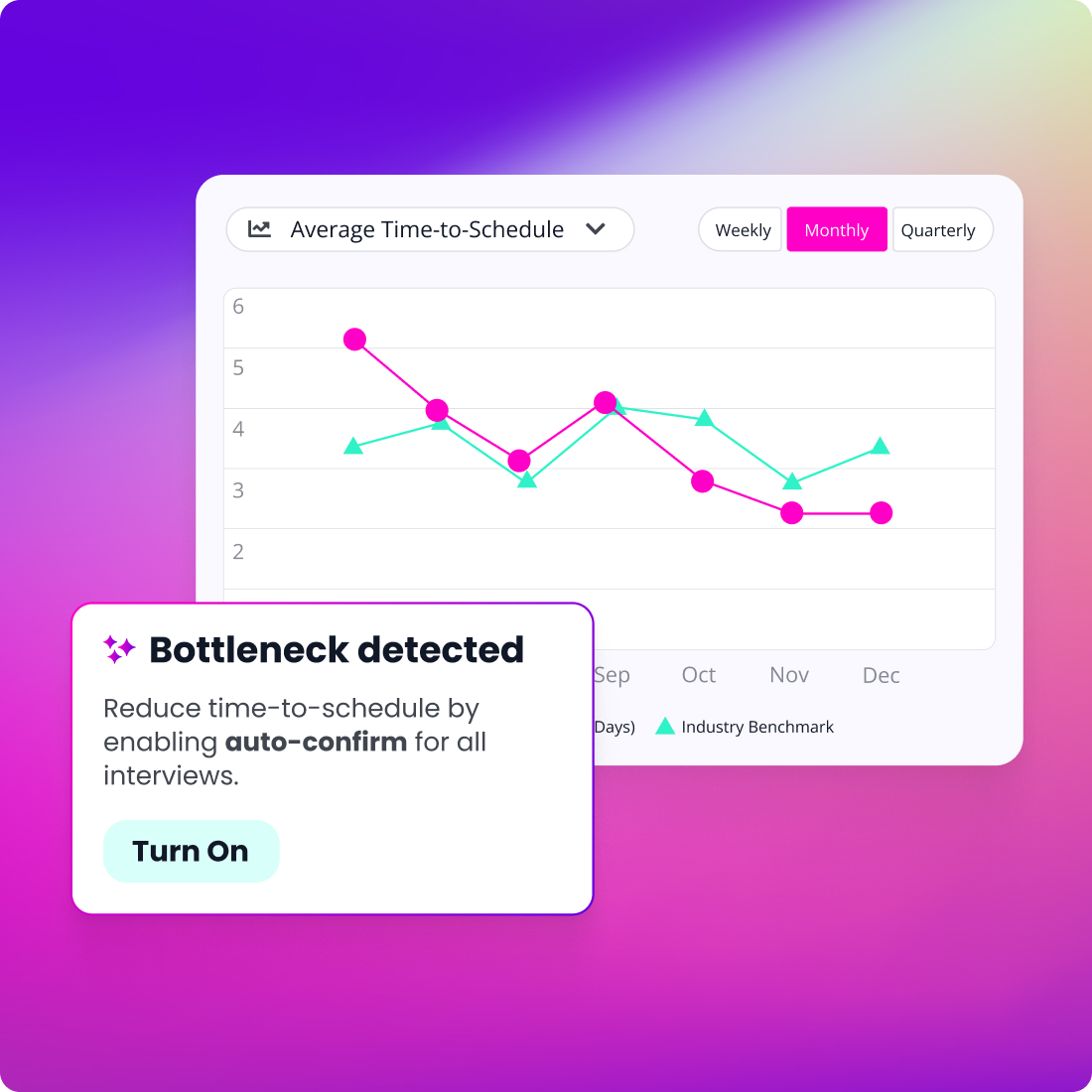

Goodtime Analytics: Data-Driven Recruiting Operations
This module provides the data needed to understand and improve your hiring process.
It turns scheduling activity into actionable insights for talent acquisition leaders.
Key Performance Indicators (KPIs)
It tracks metrics that matter for operational efficiency. This includes Time to Schedule, Interviewer Load, and overall Hiring Velocity.
These numbers help identify bottlenecks in your process.
Diversity, Equity & Inclusion (DEI) Dashboards
The platform offers dashboards that provide anonymized data on interview panel composition.
This helps organizations track their progress toward building more diverse and equitable interview processes.
This feature moves DEI efforts from a manual, often anecdotal process to a data-driven, programmatic strategy, allowing leaders to identify and address systemic biases in panel composition.
To better understand how Goodtime compares with other scheduling solutions, check out our detailed Goodtime Top Alternatives and Competitors analysis.
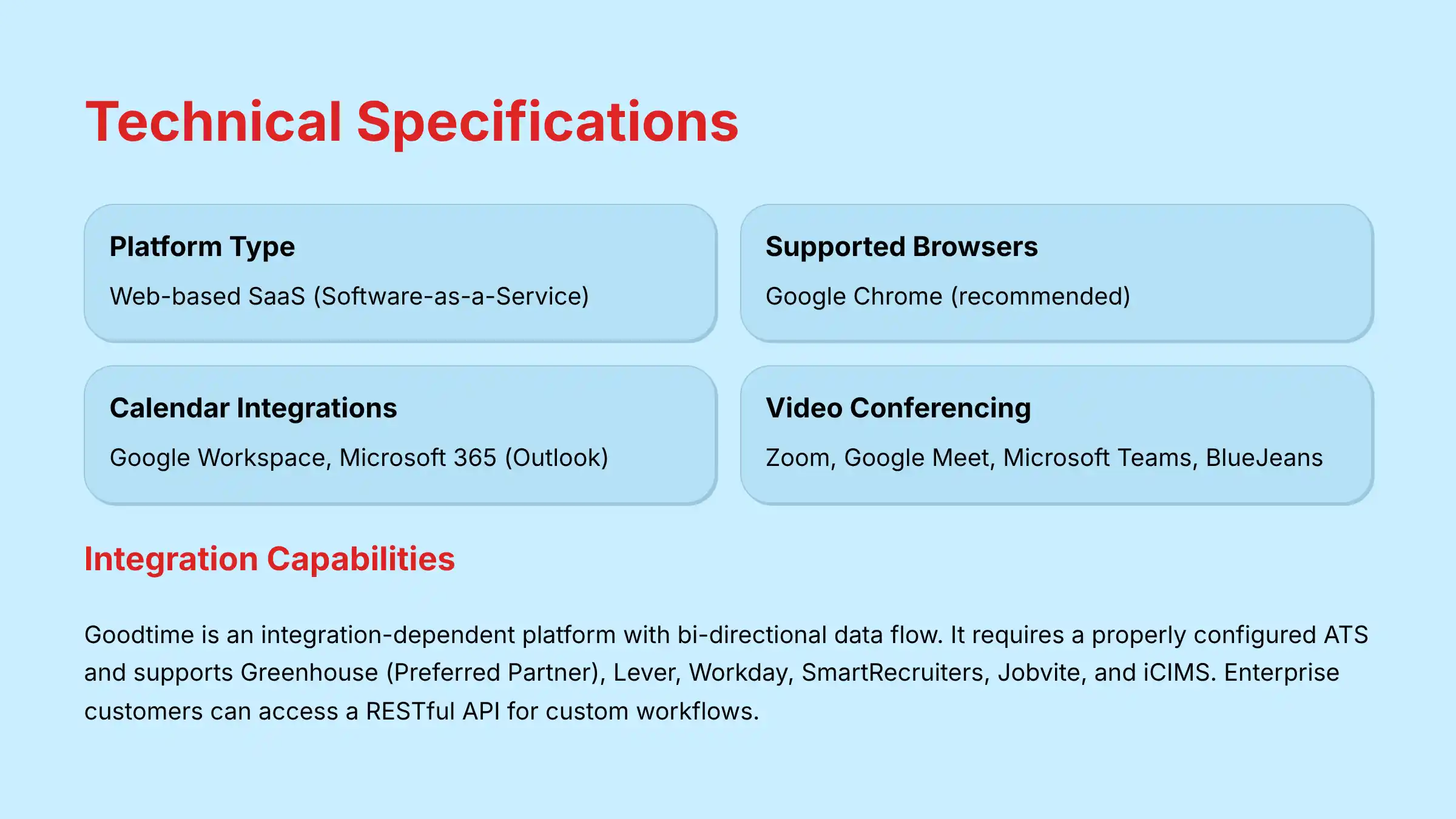

Technical Specifications and System Requirements
For any tool handling such a central function, understanding its technical foundation is necessary.
Our assessment found that Goodtime is a modern, cloud-based platform with specific integration requirements.
| Specification | Requirement |
|---|---|
| Platform Type | Web-based SaaS (Software-as-a-Service) |
| Supported Browsers | Google Chrome is the recommended browser |
| Calendar Integrations | Google Workspace, Microsoft 365 (Outlook) |
| Video Conferencing | Zoom, Google Meet, Microsoft Teams, BlueJeans |
Integration Capabilities: The Core of the Goodtime Ecosystem
Goodtime is not a standalone product; it is an integration-dependent platform.
Its power comes from its ability to communicate seamlessly with the other systems in your HR technology stack.
These are deep, bi-directional integrations, meaning data flows back and forth automatically.
Applicant Tracking System (ATS) Integrations
A properly configured ATS is a prerequisite for using Goodtime.
The platform becomes the scheduling layer on top of your system of record for candidates. Key supported integrations include:
- Greenhouse (listed as a Preferred Partner)
- Lever
- Workday
- SmartRecruiters
- Jobvite
- iCIMS
Calendar & Communication Integrations
The platform syncs in real time with the primary calendar and email systems used in most businesses.
This is fundamental to its operation. Supported systems are:
- Google Workspace (Gmail & Google Calendar)
- Microsoft 365 (Outlook & Microsoft Teams)
RESTful API for Custom Workflows
For organizations with unique needs, Goodtime provides a RESTful API.
This is typically available for enterprise customers. It allows your technical teams to build custom workflows, such as pulling scheduling data into an internal business intelligence tool or triggering interviews from another system.
Access to the API and its documentation is generally part of an enterprise-level agreement.
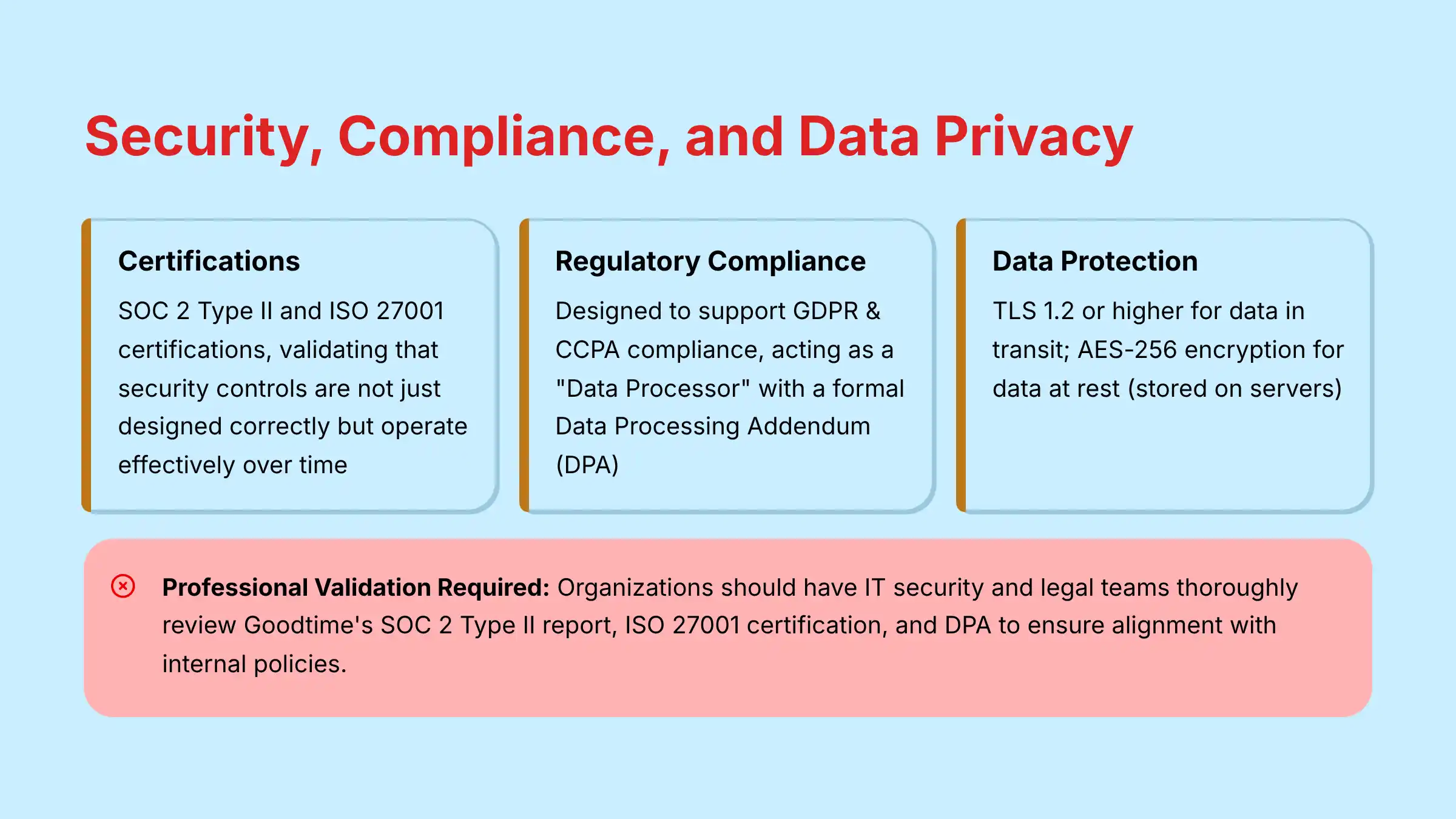

Security, Compliance, and Data Privacy (YMYL Focus)
Handling candidate and employee data requires a serious commitment to security.
In our evaluation of AI HR tools, we place a high weight on security posture. Goodtime has invested in third-party audits to validate its security controls.
SOC 2 Type II & ISO 27001 Certifications
Goodtime has achieved both SOC 2 Type II and ISO 27001 certifications.
In simple terms, this means its security practices have been rigorously audited by independent third parties.
A SOC 2 Type II report validates that its security controls are not just designed correctly but have also operated effectively over a period of time.
GDPR & CCPA Compliance
The platform is designed to support compliance with major data privacy regulations like Europe’s GDPR and California’s CCPA.
It acts as a “Data Processor” on behalf of your company. Goodtime provides a Data Processing Addendum (DPA) to formalize these responsibilities.
Data Residency and SLAs
For global organizations subject to stringent data transfer regulations, confirming the vendor’s data residency options (e.g., dedicated EU or US data centers) is a critical due diligence step.
This information is typically clarified in the DPA. Furthermore, enterprise customers should review the Service Level Agreement (SLA) to understand guaranteed uptime and support commitments for this business-critical application.
Data Encryption Standards
Data is protected using modern encryption standards. Based on their documentation, all data in transit is protected with TLS 1.2 or higher.
Data at rest (stored on their servers) is encrypted using AES-256, a standard used by financial institutions.
Professional Validation and Due Diligence: It is a professional best practice and a critical due diligence step that an organization’s IT security and legal teams thoroughly vet any new vendor. We advise a comprehensive review of Goodtime’s SOC 2 Type II report, ISO 27001 certification details, and Data Processing Addendum (DPA) to ensure alignment with your specific internal security policies and regulatory obligations.
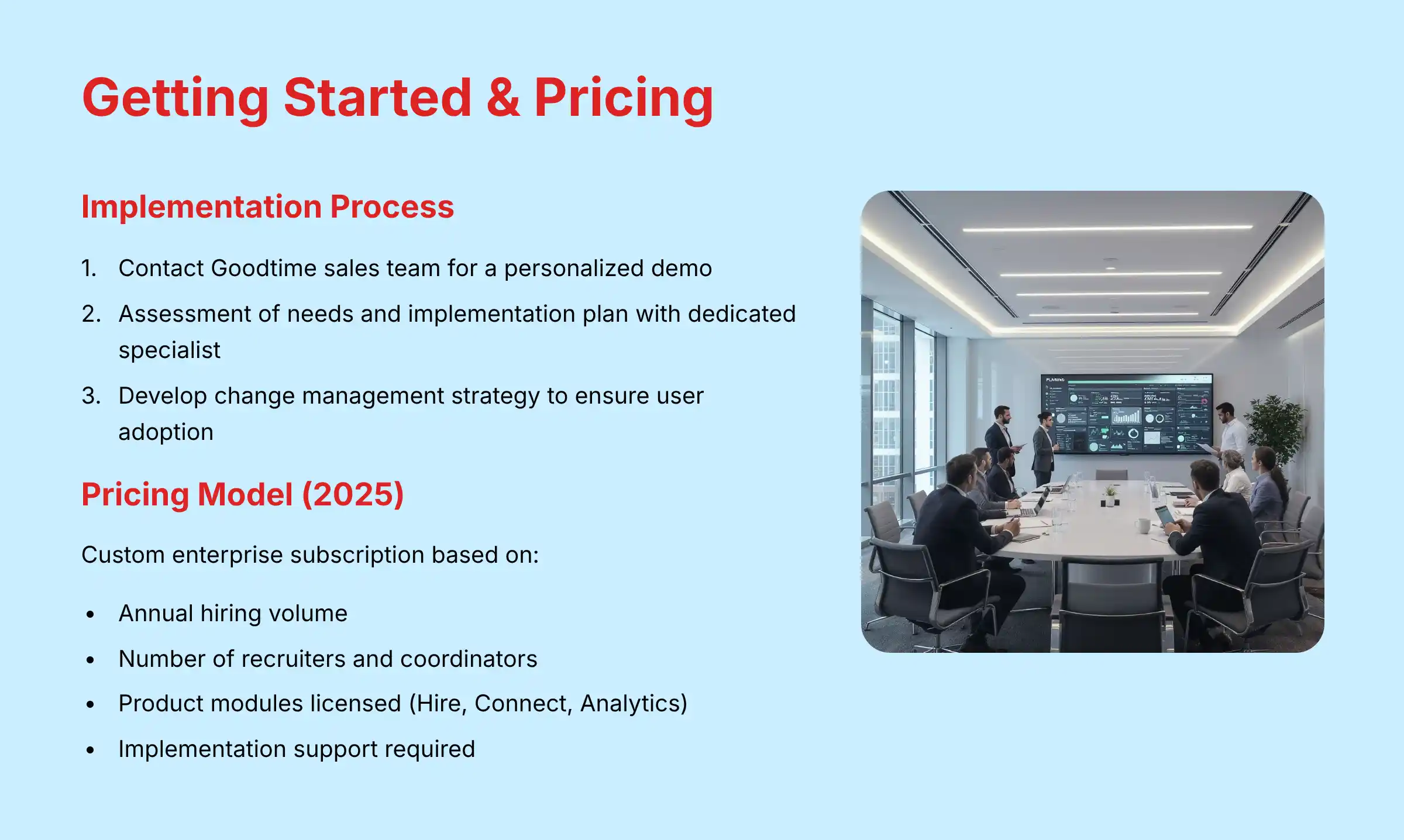

Goodtime Pricing and Plans (2025)
Goodtime does not publish its pricing publicly. The company uses a custom enterprise subscription model.
This approach is common for specialized B2B software that requires tailored implementation and support.
The final price is based on several factors. These include your company’s annual hiring volume, the number of recruiters and coordinators who will use the platform, and which product modules you choose to license (Hire, Connect, or Analytics).
The level of implementation support required also affects the cost.
To get a price, you must contact their sales team for a custom quote based on your specific needs.


Real-World Use Cases and Verifiable ROI
While these use cases demonstrate significant and verifiable ROI, a balanced and professional analysis requires an equally clear understanding of the platform’s specific scope and dependencies.
Dropbox: 90% Reduction in Time-to-Schedule
Dropbox used Goodtime to automate its complex scheduling, reducing the average time to schedule an interview from three days down to just under eight hours.
Shopify: 50% Increase in Coordinator Capacity
The platform helped Shopify’s recruiting coordinators become more efficient.
As a result, each coordinator could manage a 50% higher volume of interviews, allowing the company to scale its hiring efforts without adding headcount to the coordination team.
HubSpot: 10% Increase in Active Interviewers
Using Goodtime Analytics, HubSpot was able to get a clear view of its interviewer workload.
This data helped them balance interview requests more evenly across the team, leading to a 10% increase in the number of employees actively participating in interviews.
For a comprehensive evaluation of Goodtime’s performance and user feedback, visit our detailed Goodtime Review analysis.
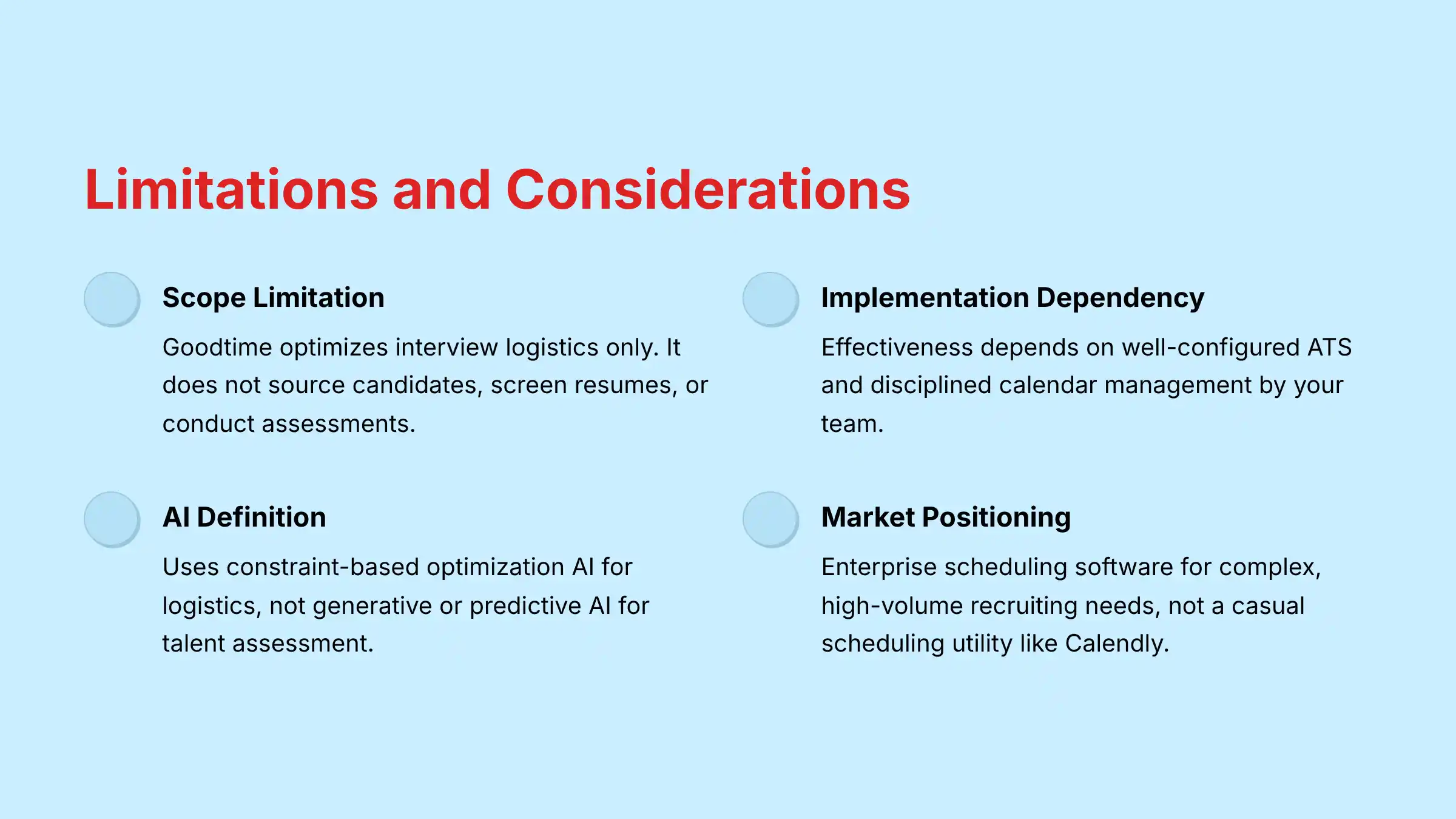

Known Limitations and Important Considerations
To provide a balanced view, it is important to understand what Goodtime is not designed to do.
Transparency about a tool’s limitations is key to making an informed decision.
- Scope Limitation: Goodtime is a coordination intelligence platform. It does not source candidates, screen resumes, or conduct assessments. It is built to optimize the interview logistics phase of recruiting only.
- Implementation Dependency: The tool’s effectiveness is directly tied to the quality of your other systems. A well-configured ATS and disciplined calendar management by your team are necessary for it to function correctly.
- AI Definition: It is critical to understand that the “AI” in Goodtime is a form of constraint-based optimization, designed to solve complex logistical puzzles. This should not be confused with generative AI (which creates content like job descriptions) or predictive AI (which forecasts candidate success). Goodtime’s AI functions as a highly sophisticated logistics engine, not a talent assessment tool.
- Market Positioning: While a basic scheduler like Calendly solves for simple 1-on-1 meetings, Goodtime operates in the enterprise scheduling software category alongside platforms like ModernLoop and Prelude. Its primary value is for organizations with complex, high-volume recruiting needs that require deep ATS integration and advanced rules for panel selection and load balancing. It is a core tool for a mature Recruiting Operations (RecOps) function, not a casual scheduling utility.
Getting Started with Goodtime
For organizations interested in the platform, the process for getting started is straightforward and consultative.
- The first step is to contact the Goodtime sales team through their official website to request a personalized demo.
- During the sales process, they will assess your needs and determine the right implementation plan. This typically involves a dedicated implementation specialist and a defined project scope. Professional Validation Point: Prospective customers should inquire about the typical implementation timeline and the required resources from their own team.
- Successful deployment goes beyond technical setup and requires a clear change management strategy to ensure high user adoption among recruiters, coordinators, and hiring managers. Goodtime provides access to a support portal and documentation to aid this process.
Frequently Asked Questions (FAQ) about Goodtime
For answers to common questions and troubleshooting guidance, explore our comprehensive Goodtime FAQs resource.
What is the primary purpose of Goodtime?
Goodtime’s main purpose is to automate and optimize interview scheduling and coordination.
It uses “Coordination Intelligence” to remove manual back-and-forth, reduce scheduling time, and improve the experience for both candidates and recruiters. It is a process optimization tool.
Is Goodtime an Applicant Tracking System (ATS)?
No, Goodtime is not an ATS. It is a specialized scheduling platform that integrates deeply with an existing ATS like Greenhouse, Lever, or Workday.
It handles the interview coordination phase after a candidate is advanced to the interview stage within the ATS.
How does Goodtime help improve interview panel diversity?
Goodtime Analytics provides DEI dashboards with anonymized data on interview panel composition.
Also, its “Smart Interviewer Selection” can be configured with rules to help ensure a diverse mix of interviewers are included, supporting DEI goals programmatically.
What are Goodtime’s key security certifications?
Goodtime holds enterprise-grade security certifications, including SOC 2 Type II and ISO 27001.
These independent audits confirm their strong commitment to security, confidentiality, and data privacy for handling sensitive information.
Does Goodtime have a public API?
Yes, Goodtime offers a RESTful API for its enterprise customers.
This allows for custom integrations and workflows, such as pulling scheduling data into internal business intelligence platforms or building unique scheduling triggers.
How is Goodtime’s pricing determined?
Goodtime uses a custom enterprise subscription model, so pricing is not public.
The final cost depends on factors like your annual hiring volume, the number of users, and which product modules (Hire, Connect, Analytics) are included in your package.
How is Goodtime different from basic scheduling tools like Calendly?
While Calendly is excellent for simple one-to-one meetings, Goodtime is designed for the high complexity of recruitment scheduling.
It manages multi-part panel interviews, automated interviewer selection based on skills, load balancing, and deep ATS integration, which basic schedulers do not support.
How does Goodtime’s Interviewer Training feature work?
Goodtime helps with interviewer training through two key functions. “Shadowing” allows a trainee to observe a live interview.
“Reverse Shadowing” allows a seasoned interviewer to observe a trainee conduct an interview. This structured process helps scale the interviewer pool effectively.
A Note on Professional Application and Technology Evolution
Technology Evolution Notice:
The information about Goodtime Overview and Features and AI Tools For HR and Recruiting tools presented in this article reflects our thorough analysis as of 2025.
Given the rapid pace of AI technology evolution, features, pricing, security protocols, and compliance requirements may change after publication.
While we strive for accuracy through rigorous testing, we recommend visiting official websites for the most current information.
Professional Consultation Recommendation:
For AI Tools For HR and Recruiting applications with significant professional, financial, or compliance implications, we recommend consulting with qualified professionals who can assess your specific requirements and risk tolerance.
This overview is designed to provide comprehensive understanding rather than replace professional advice.
Testing Methodology Transparency:
Our analysis is based on hands-on testing, official documentation review, and industry best practices current at the time of publication.
Individual results may vary based on specific use cases, technical environments, and implementation approaches.
For a continuous and updated perspective on this tool, you can refer back to our complete Goodtime Overview and Features analysis.
To explore the broader landscape of AI-powered talent acquisition tools, visit our comprehensive guide to the Best 10 AI for Talent Acquisition platforms.
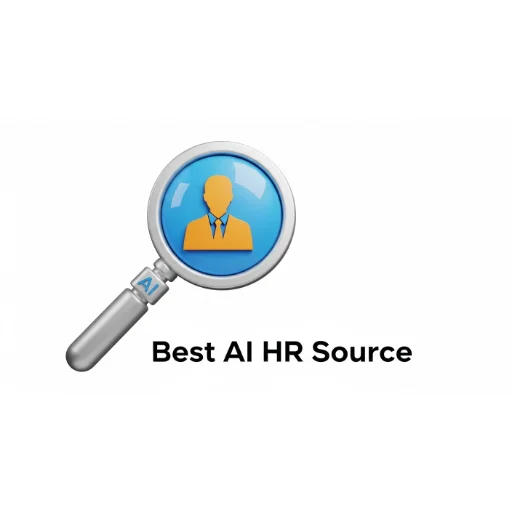
Leave a Reply